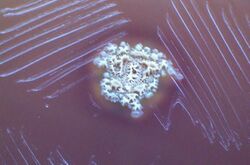Bacillus species - Overview
| Bacillus | |
|---|---|
| Phylum | Firmicutes |
| Class | Bacilli |
| Order | Bacillales |
| Family | Bacillaceae |
| Genus | Bacillus |
Overview
Bacillus species are mostly non-pathogenic, environmental organisms.
Characteristics
The bacteria are large, motile, Gram positive rods that produce endospores. They are aerobes or facultative anaerobes and are catalase positive and oxidase negative. They grow on non-enriched media. Bacillus anthracis colonies are up to 5mm diameter, flat, dry and grey with a ground-glass appearance. Curled outgrowths from the edge of the colony give a 'medusa head' appearance. They are non-haemolytic and can be differentiated from Bacillus cereus, as B.cereus is a beta-hemolytic bacterium. Bacillus licheniformis forms dull, rough, wrinkled colonies, with hair-like outgrowths. Bacillus species can often tolerate adverse environmental conditions.
See here for a list of Bacillus species
| This article has been peer reviewed but is awaiting expert review. If you would like to help with this, please see more information about expert reviewing. |
Error in widget FBRecommend: unable to write file /var/www/wikivet.net/extensions/Widgets/compiled_templates/wrt695bfd2cc97236_73759972 Error in widget google+: unable to write file /var/www/wikivet.net/extensions/Widgets/compiled_templates/wrt695bfd2cd1efd2_14619096 Error in widget TwitterTweet: unable to write file /var/www/wikivet.net/extensions/Widgets/compiled_templates/wrt695bfd2cd93f77_54859766
|
| WikiVet® Introduction - Help WikiVet - Report a Problem |
